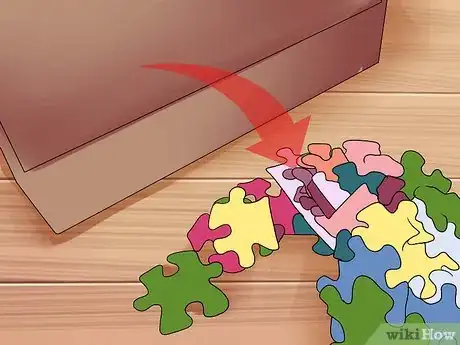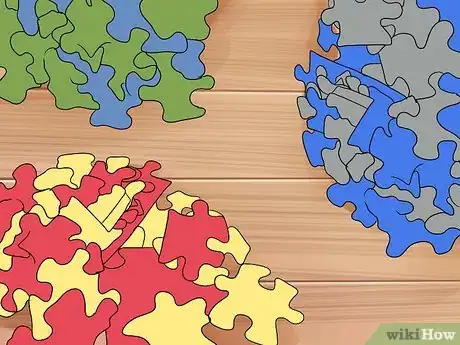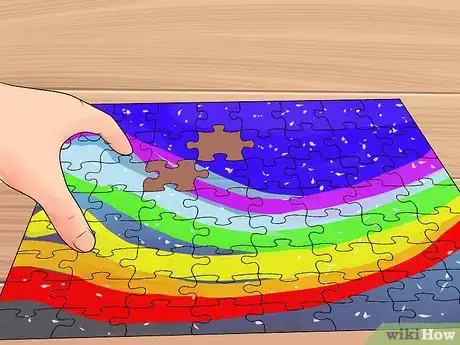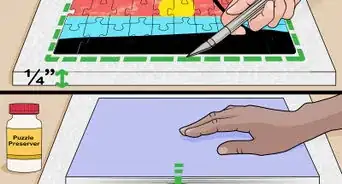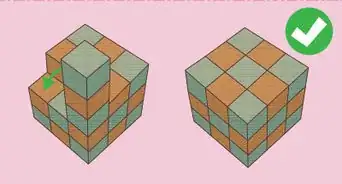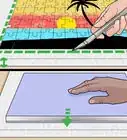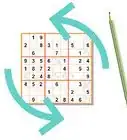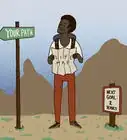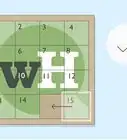This article was co-authored by wikiHow Staff. Our trained team of editors and researchers validate articles for accuracy and comprehensiveness. wikiHow's Content Management Team carefully monitors the work from our editorial staff to ensure that each article is backed by trusted research and meets our high quality standards.
wikiHow marks an article as reader-approved once it receives enough positive feedback. In this case, 83% of readers who voted found the article helpful, earning it our reader-approved status.
This article has been viewed 215,827 times.
Learn more...
These days, puzzles can have thousands of pieces. The harder puzzles can seem daunting, but just like easier puzzles, they can be finished! In fact, finishing hard puzzles may be good for your brain; research has shown that jigsaw puzzles may improve your memory.[1] With a little bit of patience and some careful planning you can be finishing difficult jigsaw puzzles in no time!
Things You Should Know
- Set up your puzzle on a flat surface that's big enough to hold your finished product.
- Sort the pieces by color or major feature. Check the picture on the box for clues.
- Arrange all of the corner pieces in a square, then add the rest of the edge pieces.
- Use the box as a reference to add in the rest of the center pieces.
Steps
Creating a Workspace
-
1Set your puzzle up somewhere that won’t be disturbed by other activities. For example, if you have roommates that eat meals at different times, it may not be a good idea to use the dining table to build your puzzle. Instead, set up a portable card table to work on or spread out a blanket in a low-traffic area.
-
2Note the size of the puzzle. This is usually printed on the side of the box. You will need an area large enough for the puzzle to lay when finished. Some people dedicate a table as "The Puzzle Table" and do not use that table for anything else during the puzzle completion, while others will set the puzzle up on a board or other flat surface that can be moved from place to place to allow use of the table for other activities between puzzle working sessions.
Sorting the Pieces
-
1Lift the puzzle pieces out of the box by hand, leaving the "cutting dust" behind. (If you dump the pieces out, you dump the "cutting dust" with them, and clutter up your work area.) Empty the cutting dust into the trash.
-
2Review the puzzle picture and note the major color or texture groupings in the picture. Sort the puzzle pieces by major color or feature.
-
3Separate out the edge pieces from the other puzzle pieces and set them on your workspace. The edge pieces have at least one completely straight side while the center pieces have no straight sides. Corner pieces, or pieces with two straight sides, are considered edge pieces.
- If you have a large enough space, you may opt to lay all the pieces out on a table at once. However, if your space is limited, you may opt to place the puzzle on a movable board and sort the pieces into bins or bowls of some sort to keep colors or shapes of a certain type together.
Matching the Edge Pieces
-
1Lay all of the edge pieces out. If you pile puzzle pieces up, you may overlook important parts of the puzzle.[2]
-
2Sort your edge pieces by color and shape.
-
3Using the image on the front of the box as a reference, arrange the corner pieces into a large square. These pieces are the foundation of the puzzle you’ll be building.
-
4Begin building the puzzle by connecting all of the edge pieces together into lines. Using the box image as a reference, arrange the lines of edge pieces next to their corresponding corners.
- When you’ve used all of the edge pieces your puzzle will look like a picture frame. Leave the center of the frame free of pieces and only put sections of completed pieces in. (Otherwise, you will have a continuous issue with removing unsorted pieces from the area where you want to work or put in completed sections.)
Adding the Center Pieces
-
1Sort the pieces by color if you have not already done so. Use the picture on the box to guide your color and shape groupings. It is important to break the work down into smaller groups so that it’s easier to tackle the project. Most puzzles have large sections with similar colors, such as large bodies of water or mountains, so sorting the pieces will give you an advantage.[3]
- One alternative to sorting is to arrange pieces in a large horseshoe shape. This arrangement will allow you to see all of the puzzle pieces by sweeping your gaze from left to right.
- Set all of the pieces out flat and picture side up. If you place the pieces into piles it will be harder to identify the pieces you need.
-
2Choose a simple area to start building. Use the box as a reference. Look for long lines, large shapes, and unifying aspects. These features will help you to quickly find the right pieces hiding among the others. Leave complicated features such as faces and small details for last. These features use fewer pieces and are therefore more difficult to find.
- If you get stuck, move to another section. The purpose of this step is to create many small groups that can be put together later.
-
3Take a break. This is the part of puzzle building that frustrates the most people. If you find yourself getting angry at the puzzle, take a quick break to clear your mind. Go for a walk, have a glass of water, or read a book. Take your mind off of the puzzle for a little while. When you return, you’ll feel refreshed and ready to search for puzzle pieces again.
- If you’ve really hit a dead end, turn the puzzle picture upside down or work from a different side of the puzzle. This will force you to search for similarities in color and shape between the pieces that you may not have noticed otherwise.
-
4Give yourself enough time to finish. Puzzles always take longer than you expect. If you’re in a rush, consider getting an easier puzzle. If you can only work on your puzzle for a few hours at a time, build your puzzle somewhere that it will be undisturbed for a few days. Once again, if you need to move around a lot while working on this puzzle, consider purchasing a puzzle board to make your puzzle mobile.
-
5Finish the puzzle. Once you’ve created small clusters of finished sections, carefully place them inside of the “frame” you built from the edge pieces. Using the top of the box as a guide, move the different clusters around until they’re in the right places. Connect the clusters together and press in any finishing pieces. You’re finished!
Community Q&A
-
QuestionWhat can I do with the puzzle when I am finished with it?
 Community AnswerSpray or brush it with clear adhesive. When it's dry, carefully flip it over and do the same. When dry, it can be framed.
Community AnswerSpray or brush it with clear adhesive. When it's dry, carefully flip it over and do the same. When dry, it can be framed. -
QuestionIf there are no distinct images (such as a puzzle with all same flowers & colors,) how could this be done more easily?
 Community AnswerThis is the most difficult kind of puzzle. For these puzzles, it's important that you build the frame first and then focus on creating smaller groups from the center pieces. If you try to tackle the whole image at once you'll get overwhelmed. Even if your groups are just two or three pieces large you'll find that creating these groups will organize the pieces and bring you closer to your goal.
Community AnswerThis is the most difficult kind of puzzle. For these puzzles, it's important that you build the frame first and then focus on creating smaller groups from the center pieces. If you try to tackle the whole image at once you'll get overwhelmed. Even if your groups are just two or three pieces large you'll find that creating these groups will organize the pieces and bring you closer to your goal. -
QuestionShould I do one color group at a time?
 Community AnswerStart with the edges, as they are the easiest. Work your way to the middle according to color.
Community AnswerStart with the edges, as they are the easiest. Work your way to the middle according to color.
Warnings
- Be patient and don't get too frustrated if it's hard. If you get frustrated , you may risk ruining all of your hard work.⧼thumbs_response⧽
References
About This Article
To put together a hard puzzle, start by sorting out the pieces into groups of edge pieces, corner pieces, and center pieces. Next, arrange your corner pieces into a large square to form the foundation. After that, connect the edge pieces to fill in the corners until your puzzle looks like a frame. Then, group your center pieces by color and choose a simple area of the picture to start building a section of the puzzle. Once you’ve created small clusters of sections, fit them inside the frame and fill in any remaining pieces. For more tips, like how to deal with the frustration of putting together a puzzle, read on!


